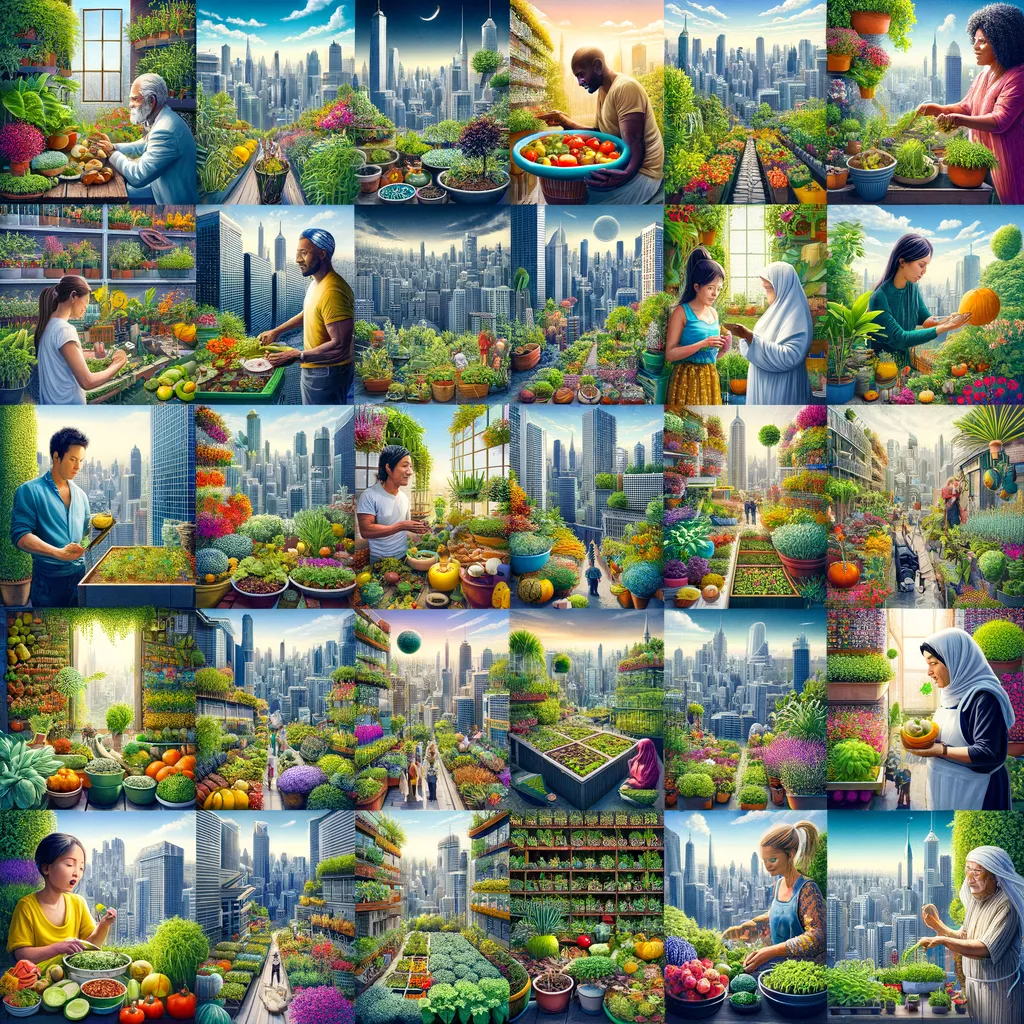The Global Rise of Urban Gardening: A Green Oasis in the Concrete Jungle
Welcome to our comprehensive guide on the thriving movement of urban gardening! As cities worldwide become denser and green spaces scarcer, the call for revitalizing our urban landscapes has never been louder. This guide aims to explore the burgeoning trend of urban gardening, its myriad benefits, and why it’s becoming an essential part of our metropolitan lifestyles. Whether you’re a seasoned gardener or a curious newbie looking to bring more green into your life, this article is your first step towards a greener, more sustainable future. Before we dive in, here’s a thought to ponder: imagine swapping the grey cityscape for lush, vibrant green spaces. Ready to learn how? Let’s begin.
For those adventurous spirits who also enjoy the great outdoors beyond your garden, check out Camping for gear that perfectly complements your urban garden adventures. And if you’re searching for the ideal spot to pitch your tent among nature, Camp places offers the best destinations.
Understanding Urban Gardening
Urban gardening, also known as urban agriculture or city farming, is the practice of cultivating, processing, and distributing food in or around urban areas. Beyond just food production, urban gardening includes animal husbandry, aquaculture, agroforestry, and horticulture. It’s a movement that transforms rooftops, balconies, empty lots, and even windowsills into vibrant, productive green spaces.
The reasons behind the rise of urban gardening are as varied as the plants that thrive within it. For starters, it addresses critical issues like food security, providing fresh, nutritious produce directly from garden to table. It’s a powerful tool for community engagement, education, and environmental stewardship. Plus, it offers a myriad of health benefits, from reducing stress to enhancing air quality. In essence, urban gardening sows the seeds for a healthier, more sustainable urban lifestyle.
The Benefits of Urban Gardening
Let’s delve deeper into the benefits urban gardening brings to individuals, communities, and the environment:
- Reduces Carbon Footprint: Growing your own food significantly cuts down on the transport emissions associated with getting produce from farm to table.
- Improves Mental and Physical Health: Gardening has been shown to improve mental health by reducing stress, anxiety, and depression. It’s also a great form of physical exercise.
- Enhances Biodiversity: Urban gardens create habitats for bees, butterflies, and birds, enriching local ecosystems.
- Strengthens Community Bonds: Gardening projects can foster community spirit, bringing neighbors together for a common cause.
- Promotes Sustainability: By focusing on local production and consumption, urban gardening encourages a more sustainable way of living.
Getting Started with Urban Gardening
Embarking on your urban gardening journey is an exciting venture that begins with understanding the basics. Here are some initial steps to consider:
- Assess Your Space: Look around your home to find suitable spots for plants. Balconies, windowsills, and rooftops can all be transformed into productive gardening spaces.
- Choose the Right Plants: Select plants that are well-suited to your area’s climate and the specifics of your space, like sunlight exposure and shelter.
- Start Small: Begin with a few plants to manage your new garden easily and expand as you gain more confidence and experience.
- Connect with Local Gardeners: Joining a local gardening community or group can provide valuable insights, support, and inspiration.
Urban gardening is more than just a trend; it’s a lifestyle shift that prioritizes sustainability, wellness, and community. By turning towards our balconies, rooftops, and backyards, we can contribute to a greener, more vibrant urban future.

The Global Rise of Urban Gardening: A Green Oasis in the Concrete Jungle
Welcome to our comprehensive guide on the thriving movement of urban gardening! As cities worldwide become denser and green spaces scarcer, the call for revitalizing our urban landscapes has never been louder. This guide aims to explore the burgeoning trend of urban gardening, its myriad benefits, and why it’s becoming an essential part of our metropolitan lifestyles. Whether you’re a seasoned gardener or a curious newbie looking to bring more green into your life, this article is your first step towards a greener, more sustainable future. Before we dive in, here’s a thought to ponder: imagine swapping the grey cityscape for lush, vibrant green spaces. Ready to learn how? Let’s begin.
For those adventurous spirits who also enjoy the great outdoors beyond your garden, check out Camping for gear that perfectly complements your urban garden adventures. And if you’re searching for the ideal spot to pitch your tent among nature, Camp places offers the best destinations.
Understanding Urban Gardening
Urban gardening, also known as urban agriculture or city farming, is the practice of cultivating, processing, and distributing food in or around urban areas. Beyond just food production, urban gardening includes animal husbandry, aquaculture, agroforestry, and horticulture. It’s a movement that transforms rooftops, balconies, empty lots, and even windowsills into vibrant, productive green spaces.
The reasons behind the rise of urban gardening are as varied as the plants that thrive within it. For starters, it addresses critical issues like food security, providing fresh, nutritious produce directly from garden to table. It’s a powerful tool for community engagement, education, and environmental stewardship. Plus, it offers a myriad of health benefits, from reducing stress to enhancing air quality. In essence, urban gardening sows the seeds for a healthier, more sustainable urban lifestyle.
The Benefits of Urban Gardening
Let’s delve deeper into the benefits urban gardening brings to individuals, communities, and the environment:
- Reduces Carbon Footprint: Growing your own food significantly cuts down on the transport emissions associated with getting produce from farm to table.
- Improves Mental and Physical Health: Gardening has been shown to improve mental health by reducing stress, anxiety, and depression. It’s also a great form of physical exercise.
- Enhances Biodiversity: Urban gardens create habitats for bees, butterflies, and birds, enriching local ecosystems.
- Strengthens Community Bonds: Gardening projects can foster community spirit, bringing neighbors together for a common cause.
- Promotes Sustainability: By focusing on local production and consumption, urban gardening encourages a more sustainable way of living.
Getting Started with Urban Gardening
Embarking on your urban gardening journey is an exciting venture that begins with understanding the basics. Here are some initial steps to consider:
- Assess Your Space: Look around your home to find suitable spots for plants. Balconies, windowsills, and rooftops can all be transformed into productive gardening spaces.
- Choose the Right Plants: Select plants that are well-suited to your area’s climate and the specifics of your space, like sunlight exposure and shelter.
- Start Small: Begin with a few plants to manage your new garden easily and expand as you gain more confidence and experience.
- Connect with Local Gardeners: Joining a local gardening community or group can provide valuable insights, support, and inspiration.
Urban gardening is more than just a trend; it’s a lifestyle shift that prioritizes sustainability, wellness, and community. By turning towards our balconies, rooftops, and backyards, we can contribute to a greener, more vibrant urban future.
5 Things Parents Should Know in Preparing for The Global Rise of Urban Gardening and Its Benefits
As parents, we’re always looking for ways to engage our families in healthy, productive activities. Urban gardening offers just that – a chance for our children to learn about nature, responsibility, and the joy of seeing their efforts come to life. Here’s what you need to know:
- Engage Your Children: Urban gardening is a fantastic way to introduce your children to the wonders of nature. You can assign them simple tasks like watering the plants or planting seeds. It’s an opportunity for hands-on learning about plant biology, ecology, and the importance of caring for the environment.
Disclaimer
The articles available via our website provide general information only and we strongly urge readers to exercise caution and conduct their own thorough research and fact-checking. The information presented should not be taken as absolute truth, and, to the maximum extent permitted by law, we will not be held liable for any inaccuracies or errors in the content. It is essential for individuals to independently verify and validate the information before making any decisions or taking any actions based on the articles.




